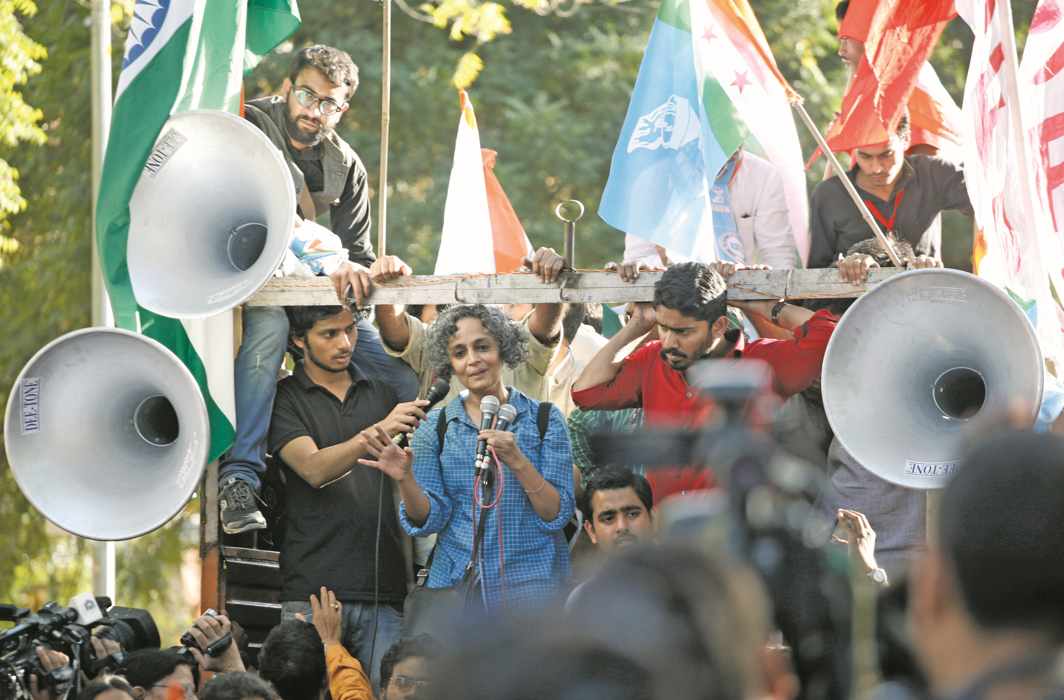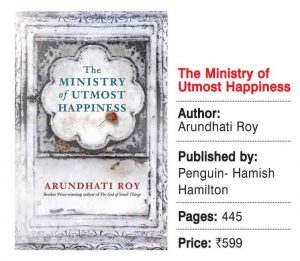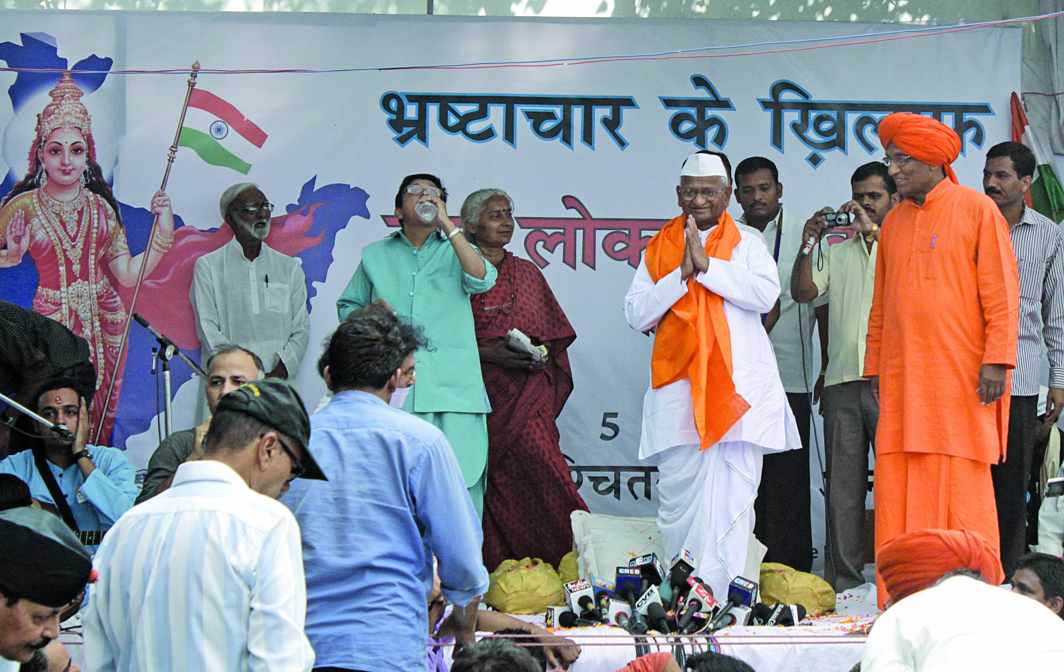Arundhati Roy’s much awaited second novel is dystopian and brimming with intense anger. It reflects the uncomfortable world we live in and manages to shake us out of our comfort zone
~By Binoo K John
These are dystopic times. If it’s not noir, it’s not a novel. Everywhere there are graveyards and people are dying or on the verge of death. This year’s Palme D’Or at Cannes went to Swedish director Ruben Ostlund’s The Square which Time magazine describes as “a sly sardonic picture about a dashing museum curator whose dysfunctional institution is a microcosm of the larger world… What does it take to jog the upper classes out of their comfortable insularity?”
In fact, the job of a novelist is the same as that of a filmmaker and the sooner he/she can rattle various classes and castes out of the insularity, the better. But pulling people out of their comfort zone is a tough creative act. Far away from the film festival circuit, another novel based in the South Kerala coast written by the up and coming Anees Salim and published this month by Penguin-Hamish Hamilton— the same publishers of Arundhati Roy (Is June the dystopia month to outgun the cruelty of April?)—also envelopes us in a dark sad world in which one of the main character is dying, dying, almost dead, wakes up from the dead, goes for a walk on the beach and finally dies again with a flourish which has a finality to it.
Anees Salim also loves the graveyard like Arundhati Roy. His graveyard appears unsurprisingly after the casual flip of the first page of the deceptively titled The Small Town Sea. To quote: “The graveyard Vappa was taken to was an unruly garden, carpeted with a thick layer of dead leaves. I had been there before… the undergrowth was like Pygmies jungles, studded with thorns as if they were guarding the dead from the living.” The graveyard appears again a bit later as if to confirm the finality of various deaths.
June being the month of dystopia, the master of them all, Arundhati Roy arrives with her own graveyard, (cruel joke to take us to a graveyard after we waited 20 years to read this and with the gleefully ironic words “Utmost happiness” in the title) which is also like the Swedish film—a microcosm of a larger world.

Roy’s graveyard has no match in recent memory. Mainly because this Nizamuddin (where this writer goes to buy beef more as a sign of rebellion than craving!) graveyard is also a place to live, not just to die. Right there on page one, the graveyard comes alive. “She lived in a graveyard like a tree. At dawn she saw the crows off and welcomed the bats home. At dusk she did the opposite. Between shifts she conferred with the ghosts of vultures that loomed in her high branches.” Some writers like Salim look at the undergrowth and others like Roy look at the high branches. Some graveyards are for the dead. Others for the living.
In terms of polemic and sarcasm and the big sword that she pierces into the heart of the ruling establishment, nothing has been written in India to match this
Roy’s novel betrays the burden of expectation, the burden of portraying an India that some of us like the author believe is getting ruptured by hate lines, the burden of drawing out a metaphor for this regressing country, the burden of standing up to all that, the burden of having changed journalism into a sword that she twisted into the rib cage of various governments, the burden of standing alone, a waif of a girl against everything, with only the power of her intellect, the unflinching daring and total mastery of the language to sustain her.
Utmost Happiness at various stages, burdened by unrelenting polemic, almost sinks (which would have left us with Utmost Sadness) with the weight of drawing out this India, but the power of Roy’s intellect, her felicity with language, the ease of her sarcasm and bitter ironies all hold up the novel and sets it up for another shot at the Booker.
 From page one it jogs us out of our comfort zone, takes us from the graveyard of Nizamuddin to the graveyards of Gujarat, of Kashmir as if the darkness of a hijra’s world with which the book starts wasn’t enough. At the release of the Italian edition of the book in Rome which this writer attended, Roy said that boundaries run through all the characters in her book. The Hijra Anjum of course crosses the boundaries of gender, her friend Saddam Hussain the boundaries of religion, a Hindu having taken on the Muslim identity, Kashmir of course not knowing where its boundaries lie and so on. (“In Kashmir when we wake up and say ‘Good morning’ what we actually mean is ‘good mourning’”) The novel thus exists in the cusp of being and nothingness. Through it all Roy trolls the undergrowth so to say, scooping up the dregs of society trying to give them a name and a meaning.
From page one it jogs us out of our comfort zone, takes us from the graveyard of Nizamuddin to the graveyards of Gujarat, of Kashmir as if the darkness of a hijra’s world with which the book starts wasn’t enough. At the release of the Italian edition of the book in Rome which this writer attended, Roy said that boundaries run through all the characters in her book. The Hijra Anjum of course crosses the boundaries of gender, her friend Saddam Hussain the boundaries of religion, a Hindu having taken on the Muslim identity, Kashmir of course not knowing where its boundaries lie and so on. (“In Kashmir when we wake up and say ‘Good morning’ what we actually mean is ‘good mourning’”) The novel thus exists in the cusp of being and nothingness. Through it all Roy trolls the undergrowth so to say, scooping up the dregs of society trying to give them a name and a meaning.
Roy’s focus no doubt are the forgotten underdogs of society whom the emerging India has pushed to the margins and is making an effort to forget them as well. “Their stories are being erased. Even in Bollywood their stories are no longer told,” Roy says.
In many sections, the novel reads like an extension of her powerful polemical essays which for the last two decades send shivers down the spine of the political class who like draughtsmen were drawing out the details of the police-CBI-military raj to replace the license-permit raj which we all despised and threw away. “The violence of exclusion and the violence of inclusion is part of the Indian project,” she says.
Brimming with anger, Roy’s novel is completely scatological as well, liberally using the words forbidden by the moral classes that dominate today’s discourse, as if to dare them. Even the bright yellow Amaltas flower that blooms in Delhi says “fuck you” to the sky over and over again.
The novel is a parade of the unwanted and the forgotten. Roy builds up for us an India we have almost forgotten in our rush to catch up with the GDP numbers and the Repo rate. We have used whiteners over the scripts of the unwashed, Roy seems to say and offers us this novel spilling with vitriol and sadness. (Why else would the copy I got be wrapped with two jackets, as if to contain all the acid within?)
Brimming with anger, Roy’s novel is completely scatological as well, liberally using the words forbidden by the moral classes that dominate today’s discourse, as if to dare them. Even the bright yellow Amaltas flower that blooms in Delhi says “fuck you” to the sky over and over again. In case the western reader fails to understand all the Delhi gaalis that liberally italicise the text, the author gives the translation as well, which considerably helps those like this author who use these words on the streets and the parlours of Delhi without really understanding their underlying mysteries.

In terms of polemic and sarcasm and the big sword that she pierces into the heart of the ruling establishment, nothing has been written in India to match this. Jantar Mantar, Nizamuddin and Old Delhi are her favourite hunting grounds. Roy goes to Jantar Mantar to completely demolish Anna Hazare and Kejriwal (Aggarwal in the novel) for what the author terms a pretend war against corruption. “Like a good prospector the old man had tapped into a rich seam, a reservoir against public anger and much to his own surprise had become a cult figure overnight.” To Anna she credits part of the middle class sense of entitlement and anger against the underclass which sustains many governments in India today. “Doodh maangogey to kheer dengey! Kashmir maangogey to chiir dengey!”
A Booker winner is entitled to take this majestic leap of faith to create a modern-day classic. Too many complications and complexities, the product of such ambition, destroy the flow of the book. Much of the stuff could have been done away with but which editor can suggest this to Roy without being put down?
Roy sees Delhi as very few have, and big novels are set in big cities. She sees the city as an evolving story. As a modern Indian novel in English, (most Indian novels are set in various comfort zones so as not to disturb its target audience) for its scale, its understanding of the larger hidden Indian story, its complete empathy with the underclasses, its utter scorn for the pot bellied ruling classes and their devious take-over schemes, the book is a classic. With this and some earlier novels, we can hope that the Indian English novel is finally liberated from, the concerns of the ruthlessly greedy middle class.
Few novels I have read or read about, have so totally identified with the deprived and the sad. Was she telling the unseen or telling the stories we refuse to see? Either way, Roy has given us a masterpiece to talk about for many years. If not anything, we all need to feel angry for a lot of things.


